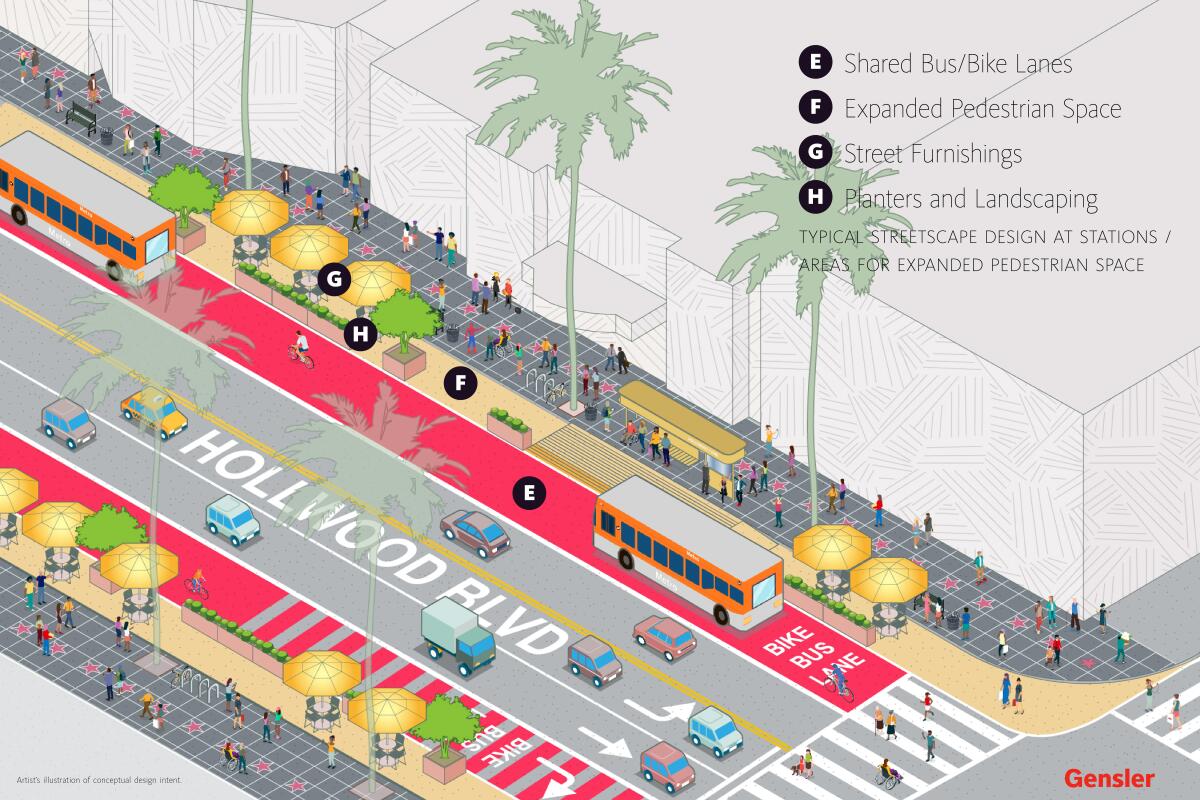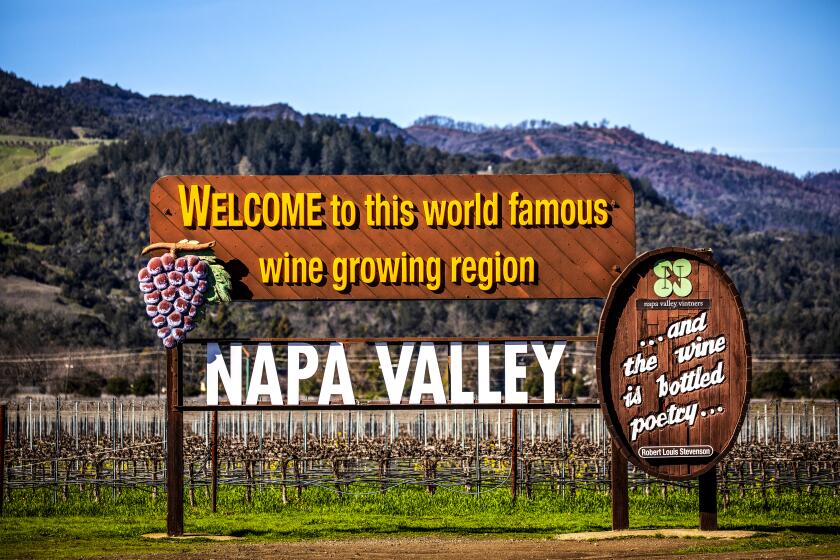Walk of Shame? Some say Hollywood Boulevard renovation could signal a new era

Tourists flock to Hollywood Boulevard by the millions every year hoping to glimpse a star and experience glamour, but what they get is a gritty thoroughfare with few trees, crumbling curbs and streetlights that don’t work.
The storied boulevard — home to the Academy Awards, TCL Chinese Theatre and the Walk of Fame — is getting a makeover. Plans are underway to revamp a 3.6-mile stretch of Hollywood Boulevard, eliminating two traffic lanes along most of the route, adding bicycle lanes and widening sidewalks, where people can linger and restaurant-goers can dine.
And the move may be a step toward a pedestrian-only boulevard, an idea that has long been floated.
“This project is about making our community safer and transforming how residents, workers and visitors use Hollywood Boulevard, “ said Los Angeles City Councilmember Hugo Soto-Martinez ahead of announcing the project on the corner of Hollywood and Vine Street on Wednesday morning.
Among the Napa Valley luminaries whose county records have been subpoenaed in a secretive federal probe are the owners of Hall Wines, Caymus Vineyards, Alpha Omega, The Prisoner — and the list goes on.
Plans have been underway for years to improve the boulevard, but this will stitch together two different efforts and modify them, adding bike lanes to the length of the roadway and eliminating about 216 parking spaces. It will also add a little more than a mile of bus lanes. The aim is to create a corridor where people don’t want to drive their cars, instead opting to stroll or pedal through.
“We know that if people come here, they will eat here, they will shop here, and they will spend their money here,” he said. “By building Hollywood around people instead of cars, we can revitalize this iconic destination.”
But Hollywood, as a whole, has bigger problems. The Walk of Fame has been poked at as the “Worst Tourist Attraction” by the luggage storage company Stasher. And, more seriously, the area has been dogged by homelessness. The same streets where the glittery red carpet is rolled out for the Academy Awards can turn sketchy the rest of the year, with people in bad superhero costumes trying to lure a few bucks from tourists.
Those messy problems aren’t something a planner can design out of the landscape, but Kathleen Rawson, president and chief executive officer of Hollywood Partnership, a business improvement district that represents 476 retailers in the area, said that she’s hopeful these plans will signal a new era.
“We see this initiative as a turning point,” said Rawson. From her office along the boulevard, she has witnessed one of Los Angeles’ most famed tourist spots fall deeper into disrepair.
The projects that the plan ties together are known as the Walk of Fame Master Plan. First unveiled by Soto-Martinez’s predecessor, it is 1.3 miles and runs from La Brea Avenue east to Gower Street. The plan was largely being carried out by the Bureau of Engineering.
The second project, a Vision Zero improvement area, was being handled by the Los Angeles Department of Transportation. The 2.3 miles between Gower and Lyman Place had been singled out because it qualifies as a “high-injury network,” roads where a disproportionate number of traffic deaths and injuries occur. Between 2010 and 2019, 53 severe and fatal collisions occurred on that stretch.
“What we’re looking forward to the most is being able to recapture some of the space that is being used by vehicles, to have it be used by pedestrians and cyclists,” she said. There’s talk of adding posts that offer security from traffic so the city can shut down streets for special events.
“We know that Hollywood Boulevard is one of the disappointing tourist attractions, because of its condition,” she said. Investment dollars have poured into downtown, she said, but it has been decades since Hollywood has seen major infrastructure funds. The partnership regularly dispatches cleaners who scrub down the bronze inlaid stars on the Walk of Fame, repair lighting and sweep the streets.
The entire project is estimated to cost about $8 million, and the area west of Gower will still require environmental review for features including landscaping and some sidewalk dining. That’s expected to be completed by 2026.
Much of the redesign of the lanes, and even sidewalk widening, could be done by next year.
The approach has garnered critics. Early on, there was concern about the loss of parking spaces, but Rawson said that was largely resolved. Hollywood has numerous existing parking spaces, including more than 3,000 at the Ovation Hollywood shopping mall, formerly Hollywood & Highland.
Still, some dislike the changes because the model will also slow traffic, a tactic used by planners to reduce high speeds often associated with deadly crashes. The project is expected to reduce car speeds along the strip by an estimated one to five minutes a mile.
“We are incredibly concerned that, as we have seen with other similar projects in L.A., this will have a negative impact on response times,” said Chris LeGras, co-director of KeepLAMoving. The advocacy group has been a vocal opponent of so-called road diets, an approach to street planning that has come into favor in recent years. LeGras said failure to gain approval from local fire agencies before building would violate local and state fire codes.
Nick Barnes-Batista, a spokesperson for Soto-Martinez, said first responders were consulted.
Firefighters say they were left out of the process.
“LAFD officials didn’t sign off on any of these plans that will cause major changes to Hollywood Blvd and the surrounding streets. They weren’t even consulted,” said Freddy Escobar, president of United Firefighters of Los Angeles City Local 112, representing about 3,400 firefighters.
More to Read
Sign up for Essential California
The most important California stories and recommendations in your inbox every morning.
You may occasionally receive promotional content from the Los Angeles Times.












